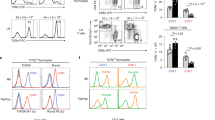Abstract
The major histocompatibility complex (MHC) of the mouse, H–2 on chromosome 17, contains several families of genes encoding cell-surface molecules which have a role in mediating immune responses1,2. The class I genes encode a family of homologous membrane proteins including the transplantation antigens K, D and L. These antigens reflect extensive genetic polymorphism which is apparent in the many different class I gene constellations or haplotypes found in mice (for example, BALB/c mice exhibit the H–2d haplotype and their class I molecules are denoted Kd, DD and Ld). Transplantation antigens serve as targets for T-cell killing in allogeneic immune responses such as in vivo graft rejection3 and destruction of allogeneic cells by cytotoxic T cells in vitro4. However, the physiological role of transplantation antigens may be to serve as restricting elements in virus-mediated T-cell killing of infected self cells. Virus infection of mice generates killer T cells whose receptors must interact with the foreign viral antigen and a class I molecule or restricting element for the cytotoxic effector function to be activated5,6. Thus the T-cell receptor recognizes the viral antigen in the context of a class I molecule. To study the interaction between the T-cell receptor and the class I restricting element, we have used the mouse L-cell transformant 8–5 which expresses Ld molecules7 and the K7-65 transformant expressing K molecules (R.S.G. et al., in preparation). Mouse L cells are fibroblasts derived from C3H mice of H–2k haplotype and monoclonal antibodies can be used to distinguish H–2d molecules from the endogenous H–2k products. Recently, we have demonstrated that both Ld (ref. 8) and Kd molecules (unpublished data) expressed on transformed L cells can act as target antigens for alloreactive cytotoxic T lymphocytes. Here we show that the Ld molecule on transformed mouse L cells can serve as a restricting element in lymphocytic choriomeningiris virus (LCMV) infection, whereas its Kd counterpart cannot.
This is a preview of subscription content, access via your institution
Access options
Subscribe to this journal
Receive 51 print issues and online access
$199.00 per year
only $3.90 per issue
Buy this article
- Purchase on Springer Link
- Instant access to full article PDF
Prices may be subject to local taxes which are calculated during checkout
Similar content being viewed by others
References
Klein, J. Science 203, 516–521 (1979).
Snell, G. D. Science 213, 172–178 (1981).
Snell, G. D., Dausset, J. & Nathenson, S., (eds) Histocompatibility (Academic, New York, 1976).
Alter, B. J. et al. J. exp. Med. 137, 1303–1309 (1973).
Doherty, P. C. & Zinkernagel, R. M. J. exp. Med. 141, 502–507 (1975).
Zinkernagel, R. M. & Doherty, P. C. Adv. Immun. 27, 51–177 (1979).
Goodenow, R. S. et al. Science 215, 677–679 (1982).
Woodward, J. G. et al. Proc. natn. Acad. Sci. U.S.A. (in the press).
Stern, P., Martin, G. R. & Evans, M. J. Cell 6, 455–465 (1975).
Biddison, W. E., Hansen, T. H., Levy, R. B. & Doherty, P. C. J. exp. Med. 148, 1678–1686 (1978).
Blanden, R. V., McKenzie, I. F. C., Kees, U., Melvold, R. W. & Kohn, H. I. J. exp. Med. 146, 869–880 (1977).
Levy, R. B., Shearer, G. M. & Hansen, T. H. J. Immun. 121, 2263–2269 (1978).
McKenzie, I. F. C., Morgan, G. M., Melvold, R. W. & Kohn, H. I. Immunogenetics 4, 333–347 (1977).
Hansen, T. H. et al. J. Immun. 126, 1713–1716 (1981).
Hansen, T. H. & Sachs, D. H. J. Immun. 121, 1469–1472 (1978).
Huang, C.-M., Huang, S. & Klein, J. Immunogenetics 9, 173–182 (1979).
Ozato, K., Hansen, T. H. & Sachs, D. H. J. Immun. 125, 2473–2477 (1980).
Woodward, J. G. et al. in B and T Cell Tumors: Biological and Clinical Aspects (eds Vitetta, E. & Fox, C. F.) (Academic, New York, in the press).
Ozato, K., Meyer, R. & Sachs, D. H. Transplantation (in the press).
Author information
Authors and Affiliations
Rights and permissions
About this article
Cite this article
Örn, A., Goodenow, R., Hood, L. et al. Product of a transferred H–2Ld gene acts as restriction element for LCMV-specific killer T cells. Nature 297, 415–417 (1982). https://doi.org/10.1038/297415a0
Received:
Accepted:
Issue Date:
DOI: https://doi.org/10.1038/297415a0
This article is cited by
-
A transgenic mouse model for the ductal carcinoma in situ (DCIS) of the mammary gland
Oncogene (2000)
-
Peptide ligand-induced conformation and surface expression of the Ld class I MHC molecule
Nature (1990)
-
A third class I major histocompatibility complex antigen encoded by a gene in the D region of the H-2 d haplotype recognized by cytotoxic T lymphocytes
Immunogenetics (1988)
-
Cytoimitiunotherapy for persistent virus infection reveals a unique clearance pattern from the central nervous system
Nature (1986)
-
Consequences of a single Ir-gene defect for the pathogenesis of lymphocytic choriomeningitis
Immunogenetics (1985)
Comments
By submitting a comment you agree to abide by our Terms and Community Guidelines. If you find something abusive or that does not comply with our terms or guidelines please flag it as inappropriate.



